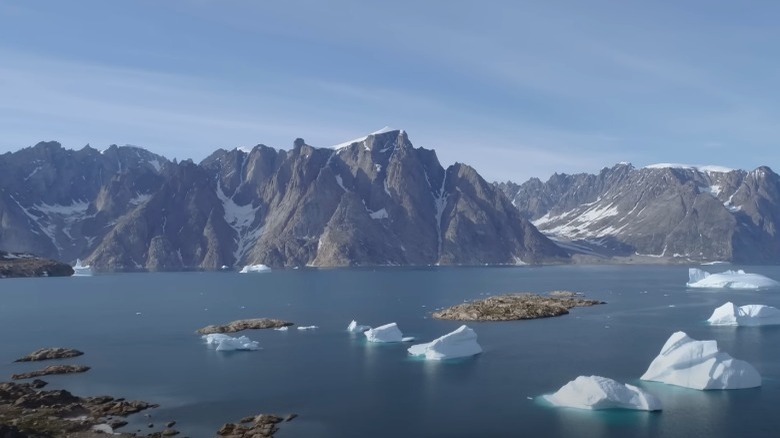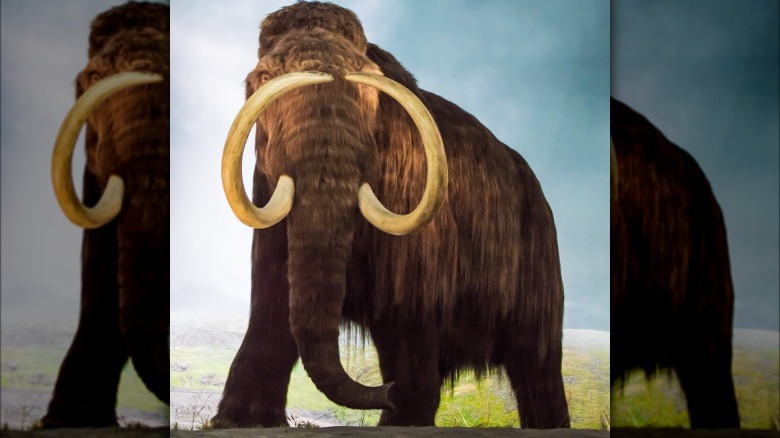The World's Oldest DNA Discovered Is Almost Twice As Old As The Previous Mark
Warming global temperatures and melting permafrost have yielded a number of scientific discoveries that were previously locked up in ice, according to Smithsonian Magazine. As a 2022 study published in Nature revealed, melting permafrost in Greenland offered a team of scientists not only a peek back in time at a previously unknown ecosystem, but DNA samples far older than any others so far uncovered. The DNA samples from the paper published in Nature also provide evidence that an extinct species once lived in Greenland that up until now had not been known to survive so far north, per Scientific American.
The record for the world's oldest DNA was previously held by samples taken from Siberian mammoth teeth from around 500,000 to 800,000 years ago, possibly dating as far back as 1 million years ago. That record had only been set one year prior to the Greenland research announcement, according to National Geographic. That such tiny and ancient samples can be examined at all reflects rapid advancements in our ability to extract useful information from minute and previously unusable DNA evidence. Fresh scientific insight into how ancient DNA interacts with an environment over time has also been provided, all raising the possibility of isolating and studying even older DNA samples down the road.
The DNA came from the Kap København Formation in north Greenland
As the Greenland study published in Nature explains, the DNA samples that as of this writing hold the record for the oldest DNA evidence ever uncovered were taken from the Kap København Formation in northern Greenland. With warmer temperatures, the Kap København area, now described as a polar desert, was far more inhabitable millions of years ago than it is today. At that time, the area was forested and DNA and fossil evidence uncovered in sediment includes plants, fungi, and animals. There was an estuary nearby and animals likely gathered near there for water and to forage lush plant life, according to Scientific American.
In the past, this part of Greenland had yielded a number of fossils, among other examples of ancient wildlife. The sediment including the DNA that has now been examined was collected quite some time ago, but up until recently, the DNA was too damaged to extract useful information. Speaking with Scientific American, senior study author Eske Willerslev from the University of Cambridge said, "Every time we had improvements in terms of DNA extraction and sequencing technology, we tried to revisit these samples," — from the Kap Københavnand area — "we failed." Now complete, a picture has emerged of an ancient ecosystem unlike any on Earth today.
Mastodon DNA was found
Among other DNA discovered in the study was mastodon, ancestors of modern elephants that up until now were not known to have ever lived in such far northern climates, according to Live Science. DNA from hares, birds, and reindeer was also isolated and examined, all dating to at least 2 million years ago, or the Pliocene period, if not older — twice as old as the previous DNA record set in 2021. Evidence of bacteria was also found in the study amid signs that birch trees once stood on the land and relative of modern-day caribou relatives roamed the area. Each DNA sample involved in the study was minuscule and it was difficult to isolate and examine each one without breaking them.
Also notable, DNA evidence of horseshoe crabs which today live no farther north than the waters off the coast of Maine was also found. In total, more than 135 different species were identified, based on Seattle Times reporting. In a statement announcing these findings, paper lead author Eske Willerslev from the University of Cambridge in England said (via Live Science), "A new chapter spanning one million extra years of history has finally been opened and for the first time we can look directly at the DNA of a past ecosystem that far back in time." These findings also offer some idea of how species adapt and change in an evolving climate as temperatures once more climb in the Kap København area.


